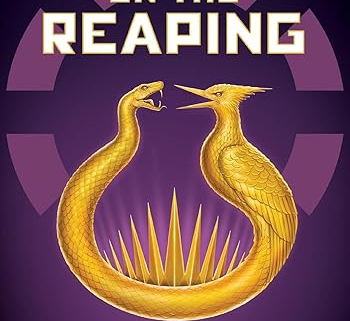In-Depth Review: Sunrise on the Reaping (A Hunger Games Novel) by Suzanne Collins
In-Depth Review: Sunrise on the Reaping (A Hunger Games Novel) by Suzanne Collins
By Nandy
Synopsis Sunrise on the Reaping

Sunrise on the Reaping plunges readers back into the brutal, politically charged world of Panem, this time through the eyes of Haymitch Abernathy, the sardonic mentor from The Hunger Games trilogy. Set during the 50th Hunger Games—the Second Quarter Quell—the novel redefines our understanding of rebellion, sacrifice, and the Capitol’s ironclad cruelty. In a twist that doubles the horror, four tributes (two boys and two girls) are reaped from each district, forcing 16-year-old Haymitch into a deadly arena where survival demands more than physical prowess—it requires defiance against the system itself.
The story opens in District 12, where Haymitch clings to a fragile hope of a quiet life with his family and fiery girlfriend, Lenore Dove, a member of the Covey, a nomadic musical group with ties to The Ballad of Songbirds and Snakes’ Lucy Gray Baird. But the Capitol’s engineered chaos disrupts his plans: during the Reaping, a botched escape attempt by another tribute leads to Haymitch’s forced conscription as a “replacement” tribute. Alongside District 12’s other tributes—compulsive gambler Wyatt Callow, sharp-tongued Maysilee Donner (later owner of Katniss’ Mockingjay pin), and Louella McCoy, whose death is swiftly covered up by a Capitol-engineered body double—Haymitch is thrust into a spectacle designed to crush dissent.
In the Capitol, Haymitch’s defiance catches the eye of Plutarch Heavensbee (then a cameraman) and President Snow, who orchestrates psychological warfare to break him. Mentored by past victors Mags (District 4) and Wiress (District 3), Haymitch joins a rebel plot led by Beetee Latier to sabotage the arena. The Games themselves—a toxic labyrinth of genetically mutated creatures and poisoned flora—become a battleground for survival and subversion. Haymitch’s alliances, particularly with Maysilee and Beetee’s son Ampert, highlight the cost of resistance, culminating in a gut-wrenching finale where the Capitol’s propaganda machine erases all traces of rebellion. The aftermath—Lenore’s poisoning, his family’s murder, and his retreat into alcoholism—paints a harrowing portrait of how trauma shapes the jaded mentor fans know.
Author Background
Suzanne Collins, the visionary behind The Hunger Games phenomenon, cements her legacy as a master of dystopian storytelling with this fifth installment. With over 100 million copies sold globally and a career spanning acclaimed children’s TV (Clarissa Explains It All) to the Underland Chronicles, Collins has redefined YA literature by blending ancient myths with biting social commentary. Her inspiration for Sunrise on the Reaping draws from Scottish philosopher David Hume’s theories on power dynamics and media manipulation, themes that resonate chillingly in today’s world of curated realities and authoritarian regimes.
Collins’ ability to humanize rebellion shines here. Like The Ballad of Songbirds and Snakes, this prequel deepens the lore of Panem while interrogating the moral rot of systemic oppression. Critics and fans alike praise her knack for crafting characters who are neither wholly heroic nor villainous—Haymitch’s arc, from hopeful teenager to broken survivor, exemplifies this nuance.
Critical Analysis Sunrise on the Reaping
1. Plot Structure and Pacing
At 400 pages, Sunrise on the Reaping balances meticulous world-building with relentless tension. The first act immerses readers in District 12’s gritty reality—coal-dust poverty, Covey ballads, and Haymitch’s tender bond with Lenore. While some critics argue the slow burn tests patience, this groundwork amplifies the emotional stakes once the Games begin. Collins’ decision to intersperse Capitol machinations (e.g., Snow’s manipulation, Plutarch’s early idealism) with arena brutality creates a dual narrative that mirrors the original trilogy’s exploration of spectacle vs. reality.
The Games themselves are a masterclass in suspense. From muttations modeled on Capitol excess to Haymitch’s strategic use of the arena’s force field, the action crescendos into a finale where survival and rebellion collide. The epilogue—featuring an older Haymitch confiding in Katniss—ties the narrative to the original trilogy, rewarding long-time fans with poignant closure.
2. Character Development
- Haymitch Abernathy: Collins strips away the cynicism to reveal a boy shaped by love and loss. His tactical genius (using the arena’s mechanics against itself) and moral complexity (allying with enemies to survive) redefine him as more than a drunk mentor. His relationship with Lenore—a blend of youthful passion and shared defiance—anchors the emotional core, making his eventual breakdown devastating.
- Maysilee Donner: A standout character, Maysilee’s wit and tragic demise (via poisoned dart) foreshadow Katniss’ resilience. Her bond with Haymitch evolves from rivalry to sisterhood, humanizing the Games’ collateral damage.
- President Snow: Though less central than in Ballad, Snow’s presence looms large. His vendetta against the Covey (echoing Lucy Gray’s legacy) and manipulation of Haymitch’s grief underscore his obsession with control.
3. Themes and Symbolism
- The Cost of Rebellion: Haymitch’s failed sabotage mirrors real-world revolutions—even in defeat, his actions plant seeds for Katniss’ eventual triumph. The Capitol’s erasure of his rebellion from broadcasts critiques modern media’s role in sanitizing history.
- Innocence and Corruption: Lenore’s orange dress (a symbol of sunset hope) and her death by Snow’s poison crystallize the Capitol’s destruction of beauty. The recurring motif of fire—Haymitch’s home burned, Katniss’ “Girl on Fire”—ties the series’ arcs together.
- Found Family: The Newcomers’ alliance, though doomed, highlights solidarity among oppressed districts. Beetee’s mentorship and Mags’ quiet strength underscore Collins’ belief in collective resistance.
4. World-Building and Legacy
Collins expands Panem’s lore with gritty details: District 12’s black market, the Capitol’s grotesque fashions (e.g., surgically attached cat ears), and the Covey’s folk songs, which subtly preserve rebel anthems. The inclusion of younger versions of Effie Trinket and Plutarch Heavensbee bridges the prequel and original trilogy, enriching their characters’ later motivations.
Reception and Cultural Impact Sunrise on the Reaping
Sunrise on the Reaping debuted as a #1 bestseller, selling 1.2 million copies in its first week—a testament to Collins’ enduring appeal.
- Praise: Fans laud its emotional depth, with Haymitch’s backstory termed “the missing puzzle piece” of the series. The exploration of propaganda and Lenore’s Covey heritage resonates with readers seeking layered storytelling.
- Criticism: Some note pacing issues in the early chapters and excessive fan service (e.g., Katniss’ parents’ cameos). Yet even skeptics admit the finale’s raw power justifies the journey.
- Cultural Moments: The #LetThemTellIt TikTok trend, where fans reenact Haymitch’s defiance, and Oprah’s tearful endorsement (“Read it with tissues!”) underscore its cultural footprint.
Personal Opinion Sunrise on the Reaping
As a Hunger Games devotee, I approached Sunrise on the Reaping with trepidation—could a prequel about a known outcome captivate? The answer is a resounding yes. Collins doesn’t just recount Haymitch’s Games; she dismantles the myth of the “unbroken hero” to reveal the boy beneath the bravado.
The arena sequences are visceral, but the quieter moments haunt most: Haymitch bartering stolen liquor to buy Lenore a ribbon, Maysilee teasing him about his “government-issued butt” shorts, or Snow’s icy warning, “Love is a weakness, Haymitch. A flaw to be exploited.” These scenes crystallize the tragedy of a boy forced to weaponize his heartbreak.
The crossover elements—Plutarch’s early idealism, the origins of the Mockingjay pin—add richness without feeling forced. Lenore’s death, though foreshadowed, shattered me; her final whisper, “Don’t let it rise on the reaping,” echoes Katniss’ defiance, binding the series’ heroines across generations.
Is the book flawless? No. The Career tributes feel underdeveloped, and Haymitch’s “aw-shucks” persona early on borders on caricature. But these are minor quibbles in a narrative that balances action, heart, and political critique. By the epilogue, where Haymitch tends to geese in memory of Lenore, I wept—not just for him, but for every character crushed by the Capitol’s wheel.
Publication Details Sunrise on the Reaping
- Title: Sunrise on the Reaping (A Hunger Games Novel)
- Author: Suzanne Collins
- Publisher: Scholastic Press
- Publication Date: March 18, 2025
- Pages: 400
- ISBN: 978-1546171461
- Genres: Dystopian Fiction, Young Adult, Political Thriller
- Content Warnings: Graphic violence, child death, poisoning, PTSD, systemic oppression
Who Should Read This Book?
- Hunger Games Fans: A must-read for lore enthusiasts and Haymitch stans.
- Dystopian Lovers: Perfect for fans of 1984 and The Handmaid’s Tale seeking action-driven narratives.
- Character Study Aficionados: Haymitch’s arc rivals Katniss and Snow in complexity.
- Newcomers: Accessible as a standalone, but richer alongside the original trilogy.
Conclusion Sunrise on the Reaping
Sunrise on the Reaping is a triumph—a gut-punch of a novel that transforms a supporting character into a legend. Collins proves once again that she is unmatched in weaving personal trauma with societal critique, crafting a story that is as much about Haymitch’s shattered heart as it is about the spark of revolution.
While the Capitol may edit out his defiance, readers won’t forget it. This book isn’t just a prequel; it’s a manifesto for hope in the face of despair. As Haymitch himself growls in the arena: “You want a show? I’ll give you a damn show.” And oh, does he ever.
Rating: ★★★★★ (5/5)
Recommendation: Buy it, cherish it, and join the rebellion. Then rewatch the films—you’ll never see Haymitch’s smirk the same way again.
Further Exploration
- Listen to Collins’ interview on The Mel Robbins Podcast dissecting Haymitch’s psychology.
- Dive into fan theories about the Covey’s musical legacy on Hunger Games Wiki.
- Pre-order the film adaptation (2026) starring Joseph Zada and Mckenna Grace—it’s already generating Oscar buzz.
Final Note: In a world where authoritarianism and media manipulation dominate headlines, Sunrise on the Reaping is a clarion call to question, resist, and remember. As Lenore sings in the meadows of District 12: “The fire you light today may warm the bones of tomorrow.” Let it ignite yours.
- Review Lost Girls: An Unsolved American Mystery by Robert Kolker
- Review: House of Earth and Blood by Sarah J. Maas
- Review: House of Sky and Breath by Sarah J. Maas
- Review: House of Flame and Shadow by Sarah J. Maas
- Review: Let Them Theory
- Review: Great Big Beautiful Life (Reese’s Book Club)
- Review: Sunrise on the Reaping
- Review: The Lost Bookshop



